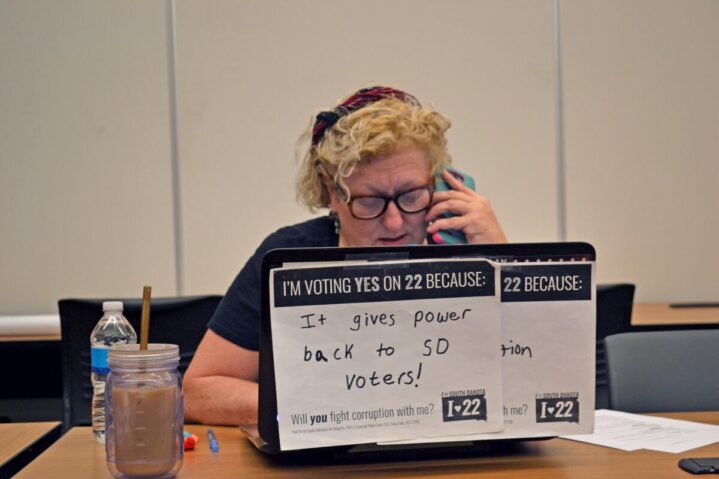How to Take Effective Political Action
How to Lead a Phonebank
Phonebanking is one of the most effective ways to easily communicate with 1,000s if not 10,000s of individuals at any given moment in your campaign.
However, in order to achieve the appropriate scale that will bring your phonebank from helpful to impactful requires putting together a team of phone bankers that can join forces and work together to increase your reach. That means hosting trainings, organizing phonebank events and putting into place a structure that will become your very own phonebank program.
You can host your phonebank virtually or in person to bring people in your local area together. Here are some things to consider when starting your phonebank program.
Before You Begin
An effective phone bank depends on 3 key factors: good management, training, and supervision. This guide will help you execute a successful phone bank with your team.

Phonebank checklist
- Choose a software. We recommend using phone bank software if possible and ideally a predictive dialer to make your phonebank the most efficient. There are plenty of software options to consider at different prices, features and user interfaces.
- Learn how to use your dialer. Super important that you know your dialer inside and out before inviting others to join. You’ll need to be able to help troubleshoot and solve tech issues that arise. You’ll also want to learn all the details around setting up your phone bank including, uploading your list, building the campaigns and scripts, and reporting and analyzing your results.
- Choose a time to call voters. You should call between 4pm Local Time and 9pm Local Time on weekdays and 10am Local Time to 9pm on weekends. Plan on a 2 hour minimum timeframe for calls.
- Find a place to make calls. You can call from your home, office, a function room, etc. Make sure your space has reliable cell service and wifi.
- Go virtual – you could choose to allow more folks to join from different locations and go virtual. We recommend using a trusted on-line meeting program to organize your phonbank supporters.
- Invite your supporters, friends, family, and local pro-democracy allies.
- Communicate details around when, where and how you plan to call so everyone knows where to be and when.
- Remind your attendees to bring
- A cell phone
- A laptop
- Preferably a headset to hook up to their phone so they can type and speak more easily
- Prep all the materials for calling
- Create a slideshow to train new callers
- Have resources that can provide more information for callers who want to dig deeper – both on how to phonebank and the campaign you’re focused on.
- Make sure your script is error free, approved by campaign leaders and is loaded into your phonebank software.
- Have fun!
- Have a potluck and bring food and drinks for your callers – if on Zoom throw a virtual call party.
- Give out stickers or candy as rewards once volunteers reach a certain number of calls – OR post emojis and memes to liven up your virtual event.
- You may also want to bring / or encourage others to bring:
- Extra laptops and/or headsets. (If you’re using a library or community center function room, check if they have any available)
- This Phonebank 101 Guide
- Scrap paper and pens for jotting down notes, difficult questions, etc from calls
- Snacks or pizza (You can ask people to chip in to cover the cost or rotate who brings what each shift)
Four Steps for a Successful Phone Bank
Step One: Get Organized
To get an effective phonebank up and running, you’ll need to do the following:
- Find a place or Zoom call, to get together to make calls. You can call from your home, a cafe, office, etc. Make sure your space has reliable cell service and wifi.
- Choose a time to call voters. You should call between 4pm Local Time and 9pm Local Time on weekdays and 10am Local Time to 9pm on weekends. Plan on a 2 hour minimum time frame for calls.
- Recruit Volunteers: Over-recruit. Recruit twice as many volunteers as you need to account for natural attrition! Recruit for specific times and dates and follow up to confirm and remind volunteers when and where their shifts are.
- Check tech, lists, and internet ahead of time: Prep all the materials you need prior to other volunteers arriving. Having a volunteer phonebank coordinator to own these responsibilities can be key to this going well.
Step Two: Create a Volunteer Shift Schedule
Developing — and strictly following — a written schedule for the phonebank shifts will ensure that you give the volunteers the information, tools, and practice they need to succeed.

Start with a campaign update, training, and practice. If you have a goal of 2 hours of call time, this should be planned outside that time. Perhaps just prior to the phonebanking event.
Then get on the phones. Calls are usually some of the most important field work being done on the campaign. With that in mind it is really important that callers are on the phones for the full duration of the planned call time. Signing up for these shifts is a commitment. A few extra dials might not seem like much — but they are. They add up and they make the difference between winning and losing.
Thank your volunteers and sign them up for another shift! We don’t have the money of wealthy special interest groups. What we do have is people power so be grateful to all the people who feed that. Personally thank everyone, and have the details of your next phonebank ready. Make a group ask as well as individual asks of everyone.
Step Three: Brief/Train Your Volunteers
A successful volunteer shift — as noted in the written schedule above — starts with a 20-30 minute briefing/training.
Brief volunteers on the status of the campaign and walk them through what they’ll be doing: what type of script (ie: voter persuasion), what types of voters they will be talking to (base, persuadable, etc…), how their work fits into the plan to win, and briefly what experiences other volunteers have had with these voters.
Ask new volunteers to come a little early and give them extra background on the campaign. Take extra time going over and practicing the technology.
Review progress from previous shifts, both to give the volunteers the sense that their shift is a part of a larger effort and to build momentum for the shift ahead. Any volunteers who were on that prior shift can share their experiences.
Role-play calls with volunteers until it sounds like a real conversation. Try “good” and “bad” role-plays for comparison and have them role-play with each other. Supervise the role-play and give feedback.
Step Four: Execute the Phone Bank
- Be prepared to answer questions from volunteers and provide assistance as needed
- Encourage volunteers to share positive calls
- Share progress with the volunteers to keep morale high
Step Five: Debrief the Phone Shift
After the phonebank is finished, bring your team back together in one space and spend some time debriefing. A good debrief is vital to keeping volunteers motivated and troubleshooting any challenges before they arise.
During a debrief you should:
- Ask how it went. This will help you build the volunteer relationships, track who’s doing a good job, who has leadership skills and who might be better suited for another activity.
- Ask what voters are saying. Any ‘buzz’ you hear from voters should be reported to the campaign organizer.
- Troubleshoot and address any situations or problems that arose during the shift.
- Praise the volunteers, acknowledging the important work that was accomplished.
- Share Stories. Volunteers should share stories — the good, the bad, the funny — with the entire group. Shared stories will give support and guidance to each other, and if one volunteer had a bad experience, another volunteer could offer sympathy and a solution that worked for them. Sharing stories is a vital part of a debrief.
- Sign volunteers up for their next shifts. Don’t let them leave without telling them when you are phone banking again and having them sign up.
- Thank volunteers repeatedly for their time.
Sample Phonebank Shift Schedule
Briefing: 5:15pm – 5:45pm — Sign people in and get them food (if in person). Have people introduce themselves. Share a campaign update. Go over call scripts and materials. Have volunteers form pairs and roleplay the script, with one volunteer playing the role of voter and the other playing the role of the caller.
Voter Contact: 5:45pm – 7:15pm — Calling! A leader should check in on volunteers having difficulty.
Break: 7:15pm – 7:30pm — Short break — ask people to bring snacks for the group!
Voter Contact: 7:30pm – 8:45pm — Get back the phones. Keep supervising, especially any latecomers.
Debrief: 8:45pm – 8:55pm — Restate importance of their work. Share stories. Thank everyone and ask them back.


